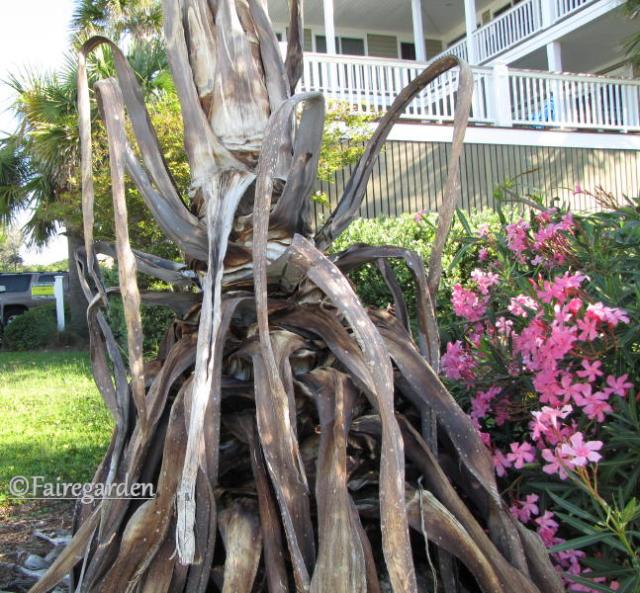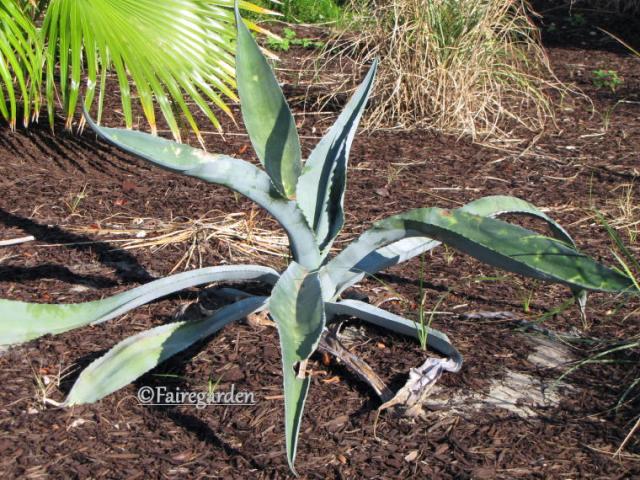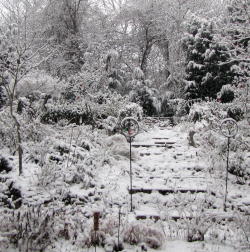
While on a recent family vacation to Isle Of Palms, South Carolina, there was a change noticed at the house we have rented for the last three years. A huge change.

From a gardener’s perspective, the first thing that catches our eye each year as the car turns into the driveway is a massive specimen of Agave americana that grows at the edge of the property, by the street. 2012 saw a change in the giant succulent. It had turned into a tree, said one of the Fairegarden clan. There was a budded bloom spike that had shot skywards.

The stem was several inches thick with a branching structure as graceful as Baryshnikov in his prime.

A little research revealed our fear to be correct, this Agave americana plant was going to bloom and then die. Inaccurately it is nicknamed the century plant by those believing the plant to bloom only after living for one hundred years, it is really more like twenty to thirty years before a bloom spike will shoot up.

Walking around the neighborhood, we found a specimen, shown above and in the photo before, that had died and was waiting to be dismantled by professionals, for the basal rosette is made up of leaves with large, thick and sharp points, a toothed margin and teeth curving downward. These leaves, growing as large as six feet across have tips that can pierce right to the bone. In addition, the sap can cause a painful rash.

Agave americana takes 10 years or so in warm regions and as much as 60 years in colder climates to send up its cyme. It dies after blooming (a condition called monocarpic), but produces offsets or “pups” throughout its life and these remain to continue the lineage. The pups had been removed from the one at our house. A few yards in the area had some of these pups mixed in their plantings, but none were in a location where a very wide and spiny plant would be welcome. They will have to be moved in the future.

How lucky then, for us to witness this phenomena of nature, for the blooms proceeded to open through the days we were there. Agave americana flowers when 10 or more years old, the exact triggering mechanism is not well understood.

These beach houses are three stories high, not including the attic/roof area. Our Agave was several feet taller than the surrounding houses. This shot was taken from the upper deck of our rental. We estimate the height at well over thirty feet.

We found the flowers themselves to be unexceptional, but the branching to be most elegant, almost Asian in its simplicity.
Some facts about Agave americana:
Hardiness: low teens; cold damage is persistent and unattractive, USDA Zones 8b-11.
Exposure: full sun, reflected heat; better in part shade than other succulents
Water: natural rainfall; better on supplemental water, once per month in summer
Soil: tolerant, good drainage; okay in shallow soils
Propagation: seed, offsets
Maintenance: minimal; removal of lower leaves can be dangerous; removal of entire dead plant after blooming can be difficult due to large size
Range/Origin: Mexican highlands but cultivated worldwide as an ornamental plant. It has since naturalized in many regions and grows wild in Europe, South Africa, India, and Australia.
Usage:
Agave americana are often used for fencing in Mexico and Central America. A dense hedge of these spiny succulents is impermeable to cattle and people. As an ornamental, century plant usually is grown in rock gardens, in cactus and succulent gardens, in Mediterranean-style landscapes, in borders, or as a specimen. It tends to dominate the landscape wherever it is grown. A. americana also is grown in containers where it stays much smaller than its outdoor brethren. Keep it in a cool, frost-free area in winter and put it out on the balcony or patio in summer. Water only in the summer.
The sap is used as a diuretic and a laxative. The juice of the leaves is applied to bruises and taken internally for indigestion, flatulence, constipation, jaundice and dysentery. Steroid hormone precursors are obtained from the leaves. The sap can cause a painful rash. (I would not recommend any internal or external medicinal uses of this plant.)
The flower stalk and heart of Agave americana are sweet and can be roasted and eaten. The seeds are ground into flour to make bread and to use as a thickener for soups. Pulque is a beer-like drink made from the fermented sap of century plant or (more commonly) the closely-related Agave salmiana. Tequila is distilled from the sap of blue agave (A. tequilana) and mescal is made by distilling fire-roasted agave. Mescal, with its distinctive smoky aroma, is often sold with a worm (actually the caterpillar of the agave moth) in the bottle. A company in California is marketing agave nectar, a sweetener made from the fruit of blue agave. (Kids, don’t try this at home.)

It is unsure if we will return to this house again next year to see the fate of the blooming Agave americana, but how fortunate we are to have witnessed this amazing sight.
***
This post is part of my friend Gail’s meme of Wildflower Wednesday.
Frances









These plants can be beasts. Lucky you to have seen one in full flower. Those towering spikes are so graceful. I have seen them in person before. There were some sort of beetles on it and hummingbirds came to the blooms. Did you grab a hold of that big stalk?? They do feel immovable like a tree.
Frances, That’s a brute…but, magnificent for sure. Too bad the rental management/lawn service has no idea they have killed off the pups. They’re gonna miss it when it’s gone. We use the agave sweetener and it’s quite good. Happy WW! xoxogail
Ironically these agaves in bloom are one of the signs of habitation in South Africa – they were popular low maintenance plants to go into dry gardens in the early part of the 20th century, often at farm entrance gates, and their progeny have survived and spread – seldom to pest proportions, but often incongruous as the fashion has changed to less intrusive indigenous plantings. Enjoy your summer holiday! Jack
Frances – that’s amazing. I never knew this about the agave plant. Thought it would bloom like the yucca with a small spike (by comparison). When I saw the first picture I thought the flower spike was a tree behind the agave. How lucky that you got to see this in bloom. How sad that it dies right after it’s most beautiful moment.
This is absolutely unique and breathtaking! What a chance that you immortalized that spectacular blooming! This is just WOW! 80
What a fortunate situation for you – not for the agave. You got to see the spectacular bloom but you won’t have to deal with the removal and clean up. And you were at the beach! Could it be any better?
How absolutely fantastic – as soon as I saw it I wondered if it was monocarpic (any opportunity to use that word makes the day a happy one!) and it is. Thank you for posting it – this is probably as close as I’ll ever get to seeing one bloom.
B.
That is a treat. I remember the last time one bloomed at the Chicago Botanic Garden. They had to remove some of the greenhouse roof for it.
I’m so glad you got to see this. I have seen it in bloom & afterward here. The after is not pretty. Also saw the pups under the dead “mother” plant.
What a mesmerizing series of pictures. I have revisited them several times today and am amazed and fascinated with each viewing. I wonder when the stalk part started to show itself and begin it’s climb to the clouds…was it in early spring? and was the increase in height noticeable on a daily basis? The branching does look very beautiful and gives a bonsai impression.
wonderful and how lucky…I have seen a few flowering at the desert botanical gardens in AZ
Beautiful photography and interesting information!
Have a great day!
Lea
Lea’s Menagerie
A truly amazing sight! We have some large Agave in our area, would love to see them blooming.
Wow, the top branches of this do look like a bonsai creation! I remember learning about the agave’s blooming and then dying on my first trip to Arizona. I did see one in bloom at the time, though I’m sure it wasn’t this tall. Such amazing plants. My daughter was thrilled when I bought her a small plant, thinking of future margaritas, I think:)
What a beautiful, amazing sight, Frances, and how lucky you and your family are to have enjoyed it. Sounds like a pretty daunting task removing one after they bloom, and die. Must be a source of mixed feelings for the owners when it blooms, knowing that death, and expensive removal will follow. Still, quite a fantastic thing to witness and enjoy.
We have these Century Plants growing in GA also! One of my earlier postings. I have been lucky to see many of them in bloom. They remind me of a Bonsai tree except much taller of course. The one I posted on never seem to die off. I found that strange as expected it to after doing some research on it. But it is in the middle of a cluster (Pups i am sure) and maybe I just could not see the dead mother plant from the car. This was a Drive By posting I did on the plant. LOL
What a lovely architectural plant. Pity it dies after flowering, and that it’s such a brute to remove. At least you got to enjoy it without the hassle of its removal afterwards.
Pingback: The Shark Tale « Fairegarden
Great picture looking head on from the 3rd story. These are so widely planted out west if you want to see one in bloom, you can drive a few miles in any direction and you’re bound to see one somewhere along the way. But I don’t think I’ve ever had the right vantage to appreciate the elegant form up the cyme. Lovely!
Pingback: Pragmatic Gardening « Fairegarden
We live in Phoenix and 5 years ago we had our front yard landscaped desert style where previously there had been grass, roses, etc. Then a few months ago a horticulturist friend was here and pointed out the stalk in the middle of our largest agave – he said it would grow about 15 feet high. We check it each day as it shoots up several inches. It is beneath an ironwood tree so not sure how far it will be able to go but as of today is about 8 feet high. We were sad to find out the mother plant will die (especially since we have another one which is now sending up a stalk) but it is an amazing site. My husband is a chef and we wondering how to roast the heart? Actually that sounds heartless but we would do it in tribute! I have a picture I could post but not sure how to.